I. INTRODUCTION
Parental characteristics are the main factor behind the students’ positive educational achievements. They play an important role in determining children’s access to school and their academic achievement (Necşoi et al., 2013). Parents are the main decision actors that directly affect children’s school enrollment and the total education period. Sending children to school is an important decision for poor households because of the financial trade-off between financial interests vis a vis child labor. Without their family’s permission and support, it is difficult for children to attend school and this tendency is prevalent in developing countries in Africa, which children are regarded as part of the labor force (Lloyd & Blanc, 1996). Among the family characteristics, the education level of parents influences children’s education achievement significantly more than other family demographic characteristics. Educated parents interact with their children better than low educated parents and they understand how to organize their home environment appropriately. These things indirectly affect children’s literacy ability, cognitive development and academic-oriented behavior, and influence academic success when they enter school (Davis-Kean, 2005). Not just academic achievement, parents’ years in education affect children’s characteristics that give them a strong desire to accomplish their aims. This achievement-oriented behavior leads them to perform better in school and after graduation. Consequently, educational achievement provides an opportunity to get a good occupation and it improves their social status.
Prior research generally confirmed that maternal education can be the standard for social economic status in developing countries (Abuya et al., 2018; Amuda & Ali, 2016). The main reason is that it is assumed that mother’s educational achievement reflects women’s high social and economic status (Sen & Clemente, 2010). Women’s educational achievement generally results to intergenerational effects on their children (Akareem & Hossain, 2016).
Compared to maternal education, the controversy regarding confirmation of paternal education on child schooling has raged unabated for many decades. Recently, the importance of paternal education has been increasing public interest related to children’s development (Schlechter & Milevsky, 2010). Especially in Sub-Saharan Africa, paternal education can be affected to their children much more than maternal education, regarding that the main body of decisions about household earnings is made by the household head. The majority of African countries are patriarchal societies which male household head is prevalent. Father has a strong influence on their children whether to send children to school or not. Even if the mother’s educational achievement is high and they understand the importance of education, father decide their children’s education with his economic resources (Booth, 2003; Timaeus & Boler, 2007). In this context, paternal education can be a more appropriate proxy to determine pupils’ educational achievement and access. There are some unobserved factors between paternal education and child schooling which cannot be grasped by mother’s educational achievement regarding Africa’s cultural backgrounds.
Many empirical studies already examined the effectiveness of mother’s education level on children’s schooling outcome. However, the relationship between father’s education level and children’s academic performance is controversial in the development field. In terms of the positive argument, a handful of research has argued that a father’s education level positively affects children’s access to school in higher education (Nyarko, 2011; Schlechter & Milevsky, 2010). For the counter argument, studies have found that a mother’s education level has a more significant influence to children’s academic achievement compared to fathers education (Eamon, 2005). A Mother’s education has a positive effect when children are young (Andrabi et al., 2012). There is clear evidence for the effectiveness of the mechanism of maternal education and child schooling for primary and secondary aged children. However, there is little research examining the positive affect between a father’s education level and children’s academic achievement in higher education cases.
Traditionally, the parents’ role has been considered as the important factor that can enhance the educational achievements of children. They play such a critical role in educating children, by affecting them physically and mentally. Moreover, parents control the decision whether to send their children to school, so understanding intrinsic parental background is prerequisite to education development (Harding et al., 2015).
Considering this concept, this study focuses on parental education which is the most basic attribute among parent’s background. It is based on the rationale that the mechanism of mother and father to their children is different for their children (Hill et al., 2016). In particular, little is known about relationship between father’s educational attainment and children’s educational outcomes in Sub-Saharan Africa. By determining the influential factors on primary and secondary aged children in Malawi, this study will examine the effectiveness of family characteristics on children’s development. First, this research will analyze the paternal education level and primary and secondary-aged children’s attendance by student’s gender, period, and parents’ gender. Second, this research will analyze the effectiveness of paternal education level on primary and secondary school aged children’s literacy by student’s gender, period, and parents’ gender. By identifying the relationship between parental educational achievement and children’s educational outcome in the context of Malawi, this research provides insights into the effects of family characteristic on economic contribution to their children in the context of Africa.
II. LITERATURE REVIEW
This chapter reviews existing empirical studies to identify major factors that are bound up with parents’ educational investment and child schooling. To examine how paternal education and maternal education are linked to their children’s education, this study assumes several figures that have the possibility of influencing children’s educational outcomes.
Parental investment is an important factor of driving success in education. Parents are the most important determinants that can directly influence children’s educational attainments. They are the main decision makers of whether send their children to the school or not. Prior research generally confirms that educational investment can be decided by socio-economic status (SES). Among SES, parents’ education level is one of important components to drive investment in education (Huisman & Smits, 2009). Parents who achieve high educational attainment understand the importance of the education compared to low-educated parents. The main reason for parental investment is strong aspiration for their children’s wellbeing. They believe that success can be achieved through education and try to provide the opportunity to obtain education (Howie et al., 2017). With parents’ economic and emotional support, this parental characteristic can result in academic achievement. It is not surprising that students’ who have well-educated parents show better academic performance and high attendance rates than students who have low-educated parents (Deslandes et al., 1999; Farooq et al., 2011; Krashen, 2005).
In that aspects of economic interpretation, parents’ education investment operates differently depending on the parents’ gender. Several studies agree that in some countries, where male-headed households are prevalent and gender disparities are large, male-headed households play an important role in sending their children to school (Shahidul, 2013; Timaeus & Boler, 2007). Even where a mother’s education level is high, she may not have the decision making power to invest in an school. In this specific local characteristic, a father’s education can be an important index in SES of family characteristics (Moyi, 2010).
Parental decision to investment in their children is prerequisite for access to school and to achieve academic skills. In terms of parents’ aspiration has affected children’s educational achievement, and this tendency has grown in accordance with parents’ educational achievement.
Previous research substantiates the belief that there are significant differences between mothers and fathers. The mechanism of paternal education and maternal education in child schooling is different. It assumed that this difference is due to which parent has the right of spending economic resources of household and this is imperative to determine parents’ decision to investment in education. In cultures, males where have the dominant decision powers, well-educated mothers do not affect their children’s access to school and the father’s education level should be a key factor to determine the children’s educational outcomes. Based on prior empirical research, this study will examine the linkage between parental education and child schooling focused on paternal education (Hossain, 2018).
This study considers several factors influencing educational investment and child schooling based on the household context. Previous studies have proven that there are several factors that have draw consequences for child schooling.
At an individual level, age and gender are the main components connected with parental education investment and children’s schooling outcome. Older children’s opportunities of attending school are higher than younger ones in same households (Takeda & Lamichhane, 2018) Regarding aspects of gender, male students have more chance to go to the school. Students’ gender should be considered together with household characteristics like parental education level. Most of the previous literature suggests that where parents and pupils are the same gender, it results in positive impacts. Father’s education has more impact on boys (Ming, 2010) and mother’s education is more associated with girl’s education (Huisman & Smits, 2009). Notably, the consensus has been that mothers strongly affect girls educational achievement. From the perspective of increasing enrollment of girls, mothers play an important role (Emerson & Souza, 2007). Considering the unique context of the African regions, gender is an important determinant to access school. Research pointed out that in patriarchal social systems like the African regions, parents prefer sending their sons to school. Compared to the opportunity cost of sending their children to school, parents might think there is more advantages sending their sons to school. Boys are more likely get good occupations in these societies. Parents think that if they educate their girls, the benefits will go to daughter’s husband’s family, so there is little motivation to educate girls. Due to this bias, expected returns of rates from girls’ education is lower than from boys in the view of the parents (Gibson & Lawson, 2011; Gibson & Sear, 2010; Olaniyan, 2011).
Of the family characteristics, research suggests household welfare and household size are decisive of educational investment and schooling. Household welfare has been argued as important in the background of parents’ decision. Welfare is the main instrumental measurement of household’s economic status. Literature generally confirms poor households cannot care about children’s education. The biggest problem households’ face is to put bread on the table, not education. Family’s who earn higher SES tends to spend more money on education (Abbam, 2018; Mingat, 2007).
In addition, bigger household size is negatively associated with children’s schooling. Children who live in large households might lose the chance to get an education for financial reasons (Cheng, 2009).
III. METHODOLOGY
This research is designed to determine relevant parents’ educational achievement and schooling outcomes. A number of researchers have reported that school attendance and literacy are the main dependent variables that can detect households’ decision to educational investment (Nguon, 2012).
Based on the literature review, there are two dependent variables to measure schooling outcomes. School attendance is used to detect access to education, and literacy is adopted to evaluate students’ academic achievements. To put it concretely, this study investigates these factors by students’ gender, parents’ gender, and a period. Autonomous variable is individual characteristics and family characteristics who are main performer of the education process. <Figure 1> is an analytical framework of factors that have the possibility of affecting children’s schooling outcomes.
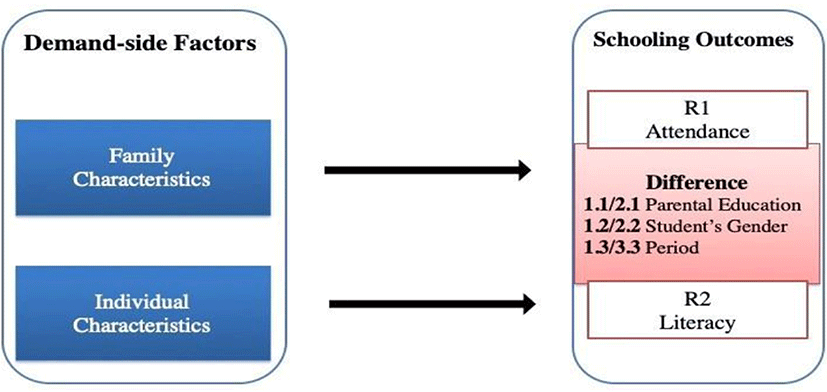
Previous studies have proven that parents’ education is affirmatively associated with their children’s education. It has a larger effect where parents’ gender and pupil’s gender is the same. Abuya et al. (2018) investigated years of maternal education at the secondary level, girls have higher academic achievement and cognitive development. Of those mothers and fathers, mother directly affects their children, but several prior literatures proved paternal education has more impact on African regions in orphan studies. Zhao et al. (2010) argued that paternal orphans show develop more trust with caregivers than maternal orphans. In addition, Dubow et al. (2009) demonstrated parental education contributes to children’s educational success in the long term indirectly. On the basis of previous empirical studies, this study investigates two hypothesis.
To be specifically, the hypothesis is, fathers’ education level affects positively male and female students, in both the short-term and medium-term. However, it has a larger effect on male students and in a medium-term. In comparison with maternal education, paternal education strongly associated with children’s schooling results. This hypothesis is based on Sánchez & Singh (2018) that represented students’ gender, parents’ gender is significantly affecting access to the school and this tendency is maintained long-term periods.
The hypothesis is fathers’ education level affects positively both male and female students, in both short-term and medium-term. However, It has a larger effect on male students and in a medium-term. In comparison with maternal education, paternal education is strongly associated with children’s literacy. This hypothesis is based on Sánchez & Singh (2018) found parental education can be directly influenced short-term, medium-term period and indirectly to the long-term period to students’ educational achievements. The researcher investigated that students’ gender, parents’ gender is significantly affecting children’s academic achievements.
The probit model was employed to analyze the probability of primary and secondary-aged children’s schooling outcomes in the form of attendance and literacy. This regression is applied to the study taking into account fact that the dependent variable is binary. Binary indicators are represented as Yi and are linked to unobserved dependent variables which are represented by Yi*. The probit model has Standard Normal Cumulative distribution function Ø(Z) and indicates binomial probabilities as follows: Pr (Yi = 1) if Pr (Y* > 0) = Ø(xTB) and Pr (Yi = 0) if Pr (Y * ≤ 0) = Ø(xTB). Based on this, Model (1), (2) is intended to detect the results of i.
children’s attendance to substantiate the first hypothesis.
Attendance 2013ij is the school attendance of individual i in household j where the baseline is 2010 and endline is 2013. It is assessed by attending status in primary or secondary school in 2013. Attendance 2016ij is the school attendance of 2016 year that individual i in household j where the baseline is 2013 and end line is 2016. Attending status of primary or secondary school in 2016 is criteria of this variable. X′ij consists of vectors observable variables (that consists of year of fathers’ education, year of mothers’ education, age, household size, household welfare, student’s gender, and student’s educational level).
Model (3), (4) is designed for demonstrating the results of children’s literacy to investigate the second hypothesis.
Literacy 2013ij is the language ability of individual i in household j where the baseline is 2010 and endline is 2013. It is made based on the children’s reading and writing ability of Chichewa or English from 2010 to 2013. Literacy 2016ij is the language ability of individual i in household j where the base-line is 2013 and endline is 2016. It is designed for children’s reading and writing ability of Chichewa or English in 2016. X′ij consists of vectors observable variables that consist of year of fathers’ education, year of mothers’ education, age, household size, household welfare, student’s gender, and student’s educational level.
The dependent variable is attendance and literacy. To measure the short-term and medium-term effects, each variable is measured twice by period. Attendance 2013 and Literacy 2013 variables show the result of short-term effects where both baseline is 2010 and endline is 2013. Attendance 2016 and Literacy 2016 variables are designed to evaluate medium-term effects that baseline is 2013 and endline is 2016 years. Household welfare is calculated by the total amount of annual non-durable expenditure to measure the household’s SES. <Table 1> is a detailed variable explanation that is used in the study.
This study uses data from the Integrated Household Panel Survey (IHPS) 2010–2013–2016 (Long-Term Panel, 102 EAs) from the World Bank. Data were collected by the National Statistical Office (NSO) in the Ministry of Economic Planning and Development (MoEPD). It is funded by the Government of Malawi (GoM), The World Bank Living Standards Measurement Study-Integrated Surveys on Agriculture (LSMS-ISA), and Millennium Challenge Corporation (MCC). Data collection started in 2010 and ended in 2016. The Integrated Household Survey 2010 is baseline of the survey and data were resurveyed in 2013 and again in 2016. IHPS is midline and IHPS is the endline of the survey.
This study targets official primary-aged children, from 6 to14 and official secondary-aged children, from 15 to 18 which can be tracked in the 2010, 2013, and 2016 periods. <Figure 2> illustrates the sample size by student’s education level and <Table 2> shows the summary statistics.
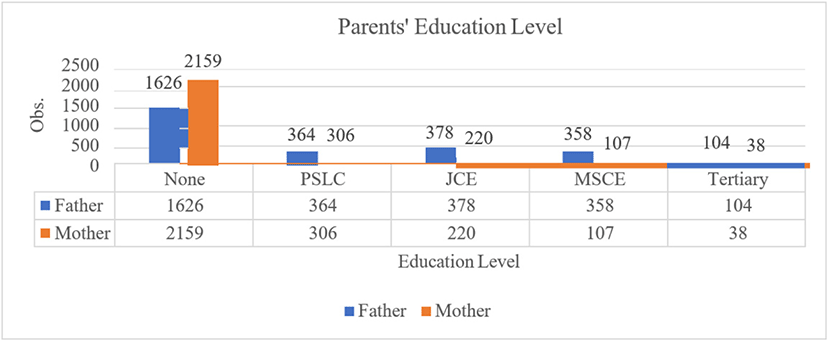
The total sample size is 2,830 of which 2,249 are primary-aged and 581 are secondary-aged children. Sample of primary-aged children are more than three times the number of the secondary-aged children. Considering the ratio of males and females, girl and boy had similar ratios. 1,402 are female and 1,428 are male students.
Mother and fathers’ year in education is shown in <Figure 2>. The majority of the people cannot obtain any educational certificate and the proportion of the uneducated mother is higher than uneducated father. Over all, there is a difference between the fathers’ educational achievement and mothers’ educational achievement at all stages. The proportion of fathers who had obtained educational certificate is higher than mothers at all stage of the education. At upper secondary and tertiary education, a number of fathers outnumbered a number of at least 2 to 1.
IV. RESULTS
<Table 3> presents the estimated results of marginal effects on primary and secondary-aged children’s educational achievements. Main independent variables are paternal education and maternal education. Furthermore, other demand-side factors are using to determine the results.
Parental characteristic is being known for the main demand-side factors that directly affect children’s schooling outcomes. However, none of the differences measured were statistically significant between parental education and children’s attendance. This result is in contradiction to the previous literature review that determined positive correlation between parental education to child schooling. In terms of control factors, there was no correlation found between control factors and children’s attendance in the short-term and medium-term. Regarding that control factors are major demand-side determinants of children’s schooling, this result is striking observation which doesn’t match with previous studies. Regarding the household characteristics, household’s welfare does not significantly affected outcomes neither in 2010 nor 2016. It is not consistent with previous literatures examined positive relevance between educational achievement and household’s economic status (Abbam, 2018; Chi & Quian, 2016). Household size is not significant. Although most studies documented household size is negatively affects to children’s attendance (Cheng, 2009; Quang, 2012), this studies cannot find positive correlation between paternal education and children’s attendance. Likewise, there are no significant results from individual characteristics. The previous literature review found increasing age affects children’s schooling and gender difference is one of the reason to determine attendance (Ming, 2010). In this study however, every independent variable are nonsignificant.
In the case of literacy, parental education is positively associated with the outcomes of the all education level, both short-term and medium-term aspects. As for paternal education, the children whose father have attained primary education, the probability is 15.1% (p<0.01) in 2013 and 9.13% (p<0.01) in 2016. The fathers that have attained lower secondary’s probability are 25.7% (p<0.01) in 2013 and 13.6% (p<0.01) in 2016. The probability of fathers with upper secondary is 22.2% (p<0.01) in 2013 and 17.1% (p<0.01) in 2016. The probability of fathers with university degree is 40.9% (p<0.01) in 2013 and 21.5% (p<0.01) in 2016. As for maternal education, it is positively associated with the outcomes of the all education level, both short-term and medium-term aspects. The children whose mother have attained primary education, the probability is 17.7% (p<0.01) in 2013 and 7.4% (p<0.01) in 2016. The mothers that have attained lower secondary’s probability are 27.9% (p<0.01) in 2013 and 9.4% (p<0.01) in 2016. The probability of mothers with upper secondary is 26% (p<0.01) in 2013 and 7.28% (p<0.01) in 2016. The probability of mothers with university degree is 24.7% (p<0.1) in 2013 and cannot statistically estimate the result from 2016. Estimated probability has a lower likelihood comparing to 2013 and 2016. Furthermore, maternal education has a lower likelihood of children’s literacy than paternal education at all education level. The results match previous studies which have documented the role of parents’ and educational achievement on children (Huisman & Smits, 2009). In the past, researchers focused on the effects of maternal education on their children (Abuya et al., 2018; Amuda & Ali, 2016). Some research has proved the correlation between father’s educational background and results in education but mainly focused on higher education, not primary education (Schlechter & Milevsky, 2010). Control factors used in this research substantiate previous empirical literatures findings. With regards to household characteristics, household welfare has positive association both short-term and medium-term. Even if coefficient is small, it is significant at 10% statistically significant. The results demonstrate that household’s economic status influences to children’s academic achievement (Mingat, 2007). Household size negatively associated with the literacy by 1.17% (p<0.01) in 2010. On the subject of individual characteristics, age is significantly associated with the literacy by 14.6% (p<0.01) in 2013 and 6.65% (p<0.01) in 2016. These findings have confirmed previous studies that increasing age affects children’s schooling (Takeda & Lamichhane, 2018). As for gender, female students’ shows 9.71% (p<0.01) in 2013 and 3.12% (p<0.1) in 2016. Male students’ result in a negative outcome of a short-term and medium-term period. This findings have documented previous studies that girl’s academic performance is better than boys (Farooq et al., 2011; Teese et al., 1995; Van Broekhuizen & Spaull, 2017). Relationship between can be clearly shown in <Figure 3> and <Figure 4> which represents interaction effects of fathers’ years in education and student’s gender. The higher fathers’ years in education, the more primary and secondary-aged children are positively correlated to the literacy irrespective of gender. Although probability slightly decreased from lower secondary (JCE) to upper secondary (MSCE), it has risen sharply from MSCE to tertiary education. Compare to student’s gender, girl always performed better than boy regardless of their father’s years in education. This tendency also can be observed in medium-term periods. Children’s literacy more likely to be enhanced with more educated fathers. Girl’s literacy is better than boys at all fathers’ years in education level but gender gap has gradually decreased. When compared girl and boy whose father had obtained university degree, there are no difference by gender. Concerning children’s education level, probability of primary-aged children’s literacy demonstrates 26% (p<0.01) in 2010. It reaches 21% (p<0.01). Whereas secondary-aged children are negatively associated with the literacy both short-term period and medium-term period. As for interaction effects as shown in <Figure 5> and <Figure 6> probability of interaction between fathers’ years in education and primary-aged children are strongly significant with the children’s literacy in the short-term period. Even if there are slight decreasing from lower secondary (JCE) to upper secondary (MSCE), interaction between fathers’ years in education and children’s literacy have increased steadily. Compared primary and secondary, primary-aged children always positively correlated to the children’s literacy. Similar results are investigated in medium periods. One interesting thing is that children who had university-degree father are strongly positively significant primary-aged children as well as secondary-aged children. It suggests father who was college-educated can have the greatest effect on children’s schooling.
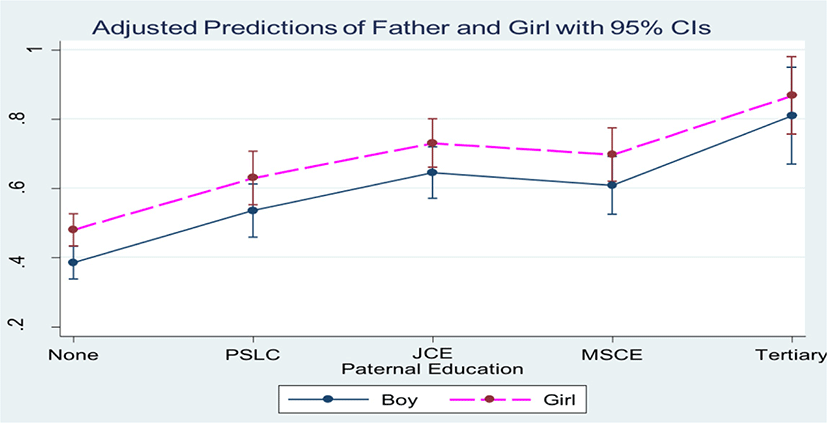
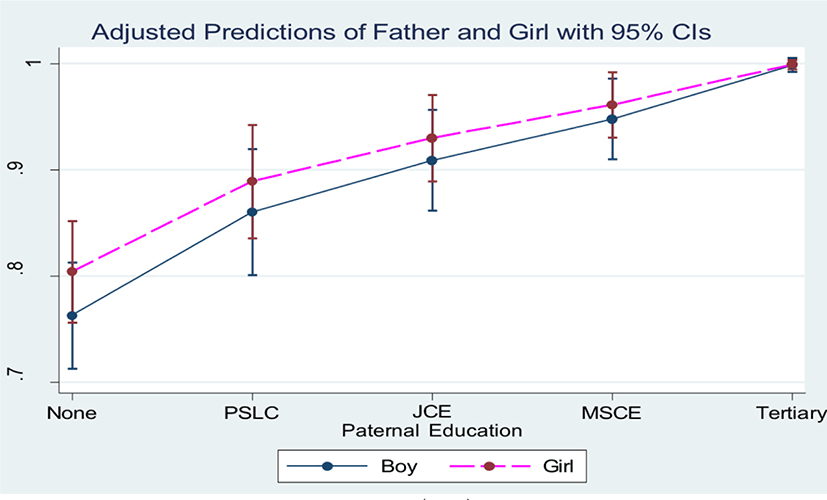
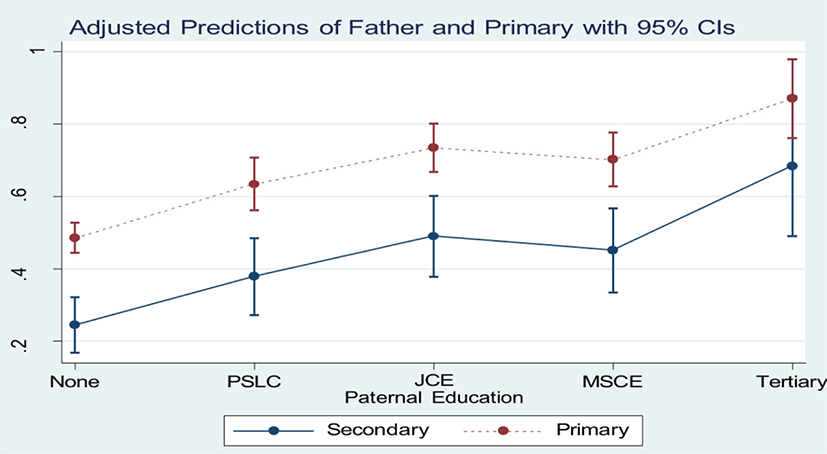
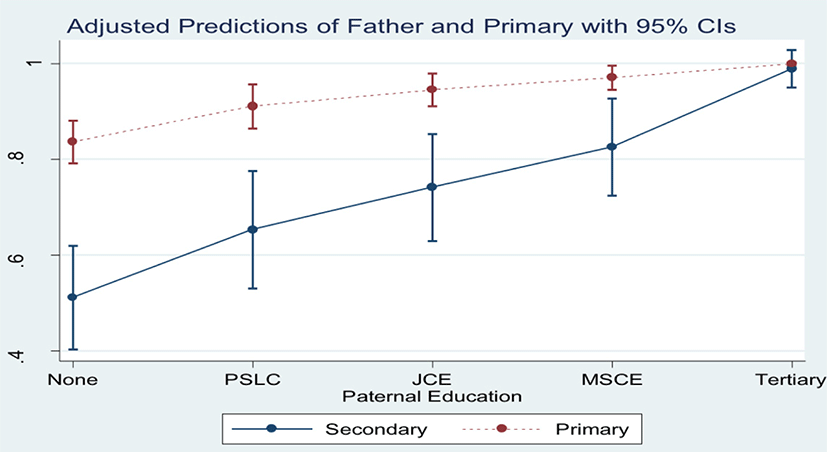
There are several limitations in this research. Firstly, there are unobserved variables. This study uses demand-side factors especially focused on family characteristics. Supply-side factors might have possibility to influence to the results like national education expenditure, lack of resources, misallocation of the education budget and low quality of the school facility can be the unobservable factors of the results. Secondly, the research has omitted variable problem. It is not possible to measure the correlation between maternal education and children’s literacy who had obtained university degree due to statistical problem. Related to the sample which used in this study, only 38 mothers can be observed who had obtained university-degree. In Malawi, only few female students can get a chance to go to the university, and girl’s drop-out rate is significantly high even if primary-level. At first educational stage, they miss the chance to continue their studies. In this Malawi’s context, it is obvious that university-degree sample size is extremely small. It can be the one of the reasons why statistic tool cannot gain the results of university-degree mothers. Furthermore, the dependent variables are binary due to the data limitation.
V. DISCUSSION
This research ushered in understanding demand-side factors specifically focusing on paternal education. Most researches regarded maternal education as a better predictor of children’s educational outcomes (Eamon, 2005; Nguon, 2012). Compared to maternal education, father has no significant correlation or lesser effects on the children’s educational outcomes. Particularly, the role of mother has been highlighted to develop children’s literacy (Waldfogel, 2006) and father does not regard as the main determinants (Flouri & Buchanan, 2004). In this sense, this study calls into question the common findings, and provides the possibility that paternal education is an appropriate proxy to enhance children’s educational outcomes in Malawi. Educated father generates the intergenerational effect of education.
As for Africa’s context in which males hold the purse strings, children’s education depends on father’s perception of education. If fathers recognize the importance of education, it can affect children’s educational outcomes (Amadiume, 2015; Atta, 2015). In this sense, the observation that significance of paternal education on children’s literacy might be possible explanation in Malawi.
Although Malawi consists both of matriarchal society and patriarchal society, women usually lag behind in many ways. Gender discrimination is predominant in Africa and the majority of female cannot obtain opportunities to attend school.
Putting children in education opportunity is a big decision for parents in developing countries. The household income of the poor is extremely low and the cash flow is unstable. The household’s priorities are taking care of urgent economic problems for their daily livelihood. Education is a matter of opportunity cost for parents. Even when the education fee is free or low, parents still have to pay pocket educational expenditure (Arnold et al., 2011). In that sense, if parents know the importance of education, they would gladly invest their economic resources in caring for children directly and indirectly. Usually, boys obtain higher chances of schooling, which creates gender-related discrepancies related to education. Compared to boys, girls are in danger of early marriage (Fisher et al., 2017). These tendencies of early marriage hinder girl’s educational attainment as it is directly linked to low-development in maternal education. Parents do not invest economic resources to girl and female students cannot get an opportunity to get an education in the school. Considering that the male is the main decision-maker who holds the purse strings, interaction between paternal education and girl’s literacy can be explained in the Malawi context. Elaborating on this point, there is a need for a new policy design that target female with the sacrifice of male. Policy suggestions are drawn by considering the constraints women face in developing countries. Taking policy actions that are explicitly focused on female may by necessary over a period of time in order to overcome prevalent gender inequality.
Malawi is young country which led by young people. People whose age are over 65 is almost 4% as opposed to 48% of children that are age is below 15 years old. It implies that education of youth is important to develop human capital giving consideration to Malawi’s demographic composition. Among the total population, males make up 48% and females 52%. Likewise gender ratio, Malawi society consists both of patriarchy and a matriarchy. Central and southern regions are composed of matriarchal societies and northern region is known as a patriarchal society. Some of the South-western parts are dominated by patrilineal cultures as well (Berge et al., 2014). Even if ratio of male to female and matrilineal to patrilineal culture is similar, Malawi has many restrictions on women’s right. Gender discrimination is predominant not just patriarchy but also matriarchy. Main monetary asset in Africa is land and it is inherited by father to son in patriarchy system. It same goes for matriarchy that majority of property are passed to mother’s brothers. As a result, women cannot own their land both matriarchy and patriarchy (Berge et al., 2014; Hatcher et al., 2005). It implies that majority of female are of low socioeconomic status and they cannot be regarded as financial assets in households. Parents do not feel necessity of girl’s education and male’s number of years in education year is higher than a female. Although gender disparity has decreased incrementally, there still exists huge gap between the male and the female. Under limited financial resources, parents consider the opportunity cost when they decide to send their children to the school. Usually, boys have higher chances of attending school and it results in a big difference related to the number of years of education. Compared to boys, girls are in danger of early marriage even if people who are under maternal systems. Before 18 years old, 64% of females were their first sexual encounter, compared to 42% of males.
This study explores how fathers’ educational background influences children’s schooling outcomes in the form of attendance and literacy. The sample of the target is official primary-aged (6–14) and official secondary-aged (15–18) children in Malawi. The study period is restricted to from 2010 to 2016. In this investigation, both of the paternal education and maternal education do not affect primary and secondary-aged children’s attendance. Even where fathers’ years in education is secondary or tertiary, it is not significant for attendance both in the short-term and medium-term. This finding is different from previous studies which examine the correlation between parents’ educational background and access to school. Considering that other control factors also have no significant correlation, it might be presumed that other decisive factors are existing in Malawi different from other countries. In contrast to attendance, correlation between parents’ educational background and children’s literacy is always positive. Particularly, fathers’ educational achievement is strongly associated with the literacy in the short term and medium term. These findings are consistent with the few empirical studies that have been proposed to explain importance of fathers’ role in children’s educational achievements (Flouri, 2005; Sarkadi et al., 2008). With regarding to gender, girl illustrates positively associated with literacy both short-term and medium-term. It corroborates Africa’s current tendency that female’s academic performance tends to be superior than for males. Progress in International Reading Literacy Study (PIRLS) 2016 report has proven that girls performed better than boys and this gender disparity is one of the main characteristics in South Africa. Reports stated 84% of boys did not reach the lowest evaluation standard compared to girls ratio of almost 72%. Similar results were shown in the 2011 PIRLS report as well. There are many reasons that might explain the pupils’ achievement. From among the factors, this paper underlines parental education is one of factors affecting children’s schooling outcomes. This finding corresponds to the interaction terms with paternal education and student’s gender. Research has found that father and girl are significantly associated with the children’s literacy both short-term and medium-term.
Notably, intergenerational impacts have proven to be a more effective between mother and daughter (Nguon, 2012; Muller, 1998). In contrast with previous empirical studies, this research has found significant interaction between father and daughter. More educated the father, the more daughters improved their literacy. This interaction has a much greater effect than between father and son. Even if the role of mother’s educational background has been highlighted for a long time, this study suggests that paternal education can be an important proxy in Malawi not only boy’s education but also girl’s education. Few researches have examined relationship between father on daughter (Franklin & Boyd-Franklin, 2000; Zia et al., 2015) but usually mother and daughters’ interaction effects are used as proxy in the research (Chatterji, 2018).
To address the pupil’s educational level, primary-aged children are always significantly associated in the short term and medium-term. Paternal education always positively associated with primary-aged children’s literacy. Compared to primary-aged children, secondary-aged children negatively associated with the literacy. The previous study has found that accessibility of primary school is better than secondary school because of free primary tuition fee (Inoue & Oketch, 2008; Riddell, 2003). Interestingly, among students with college-educated fathers are strongly likely to have high literacy ability regardless of student’s educational level and gender. This finding coincides with the previous studies that has determined positive correlation between fathers’ characteristic and children’s’ schooling outcomes (Nyarko, 2011). This result highlight again that father’s educational background is important determinants children’s educational achievement, and it might be explained through gender characteristic of Malawi society which man gained power in various aspects.
Comparing short-term and medium-term period, paternal education can enhance children’s literacy short-term as well as medium-term. However, medium-term was detected less likely to improve children’s literacy. There may be a short-term effectiveness between paternal education and children’s literacy and it to last, but less effective as time goes by.
Together these results provide crucial insights into parental characteristic on child schooling which specifically focused on paternal education. In response to the hypothesis question 1, there was no significant increase of paternal education associated with children’s literacy both short-term and medium-term. In response to the hypothesis 2, parental education positively significant to children’s literacy skills. To be concrete, girls are significantly correlated with paternal education than boys and primary-aged children are significantly correlated to paternal education than secondary-aged children. In terms of period, both of the short-term and medium-term has positively associated with the children’s literacy but short-term period have more impact.
